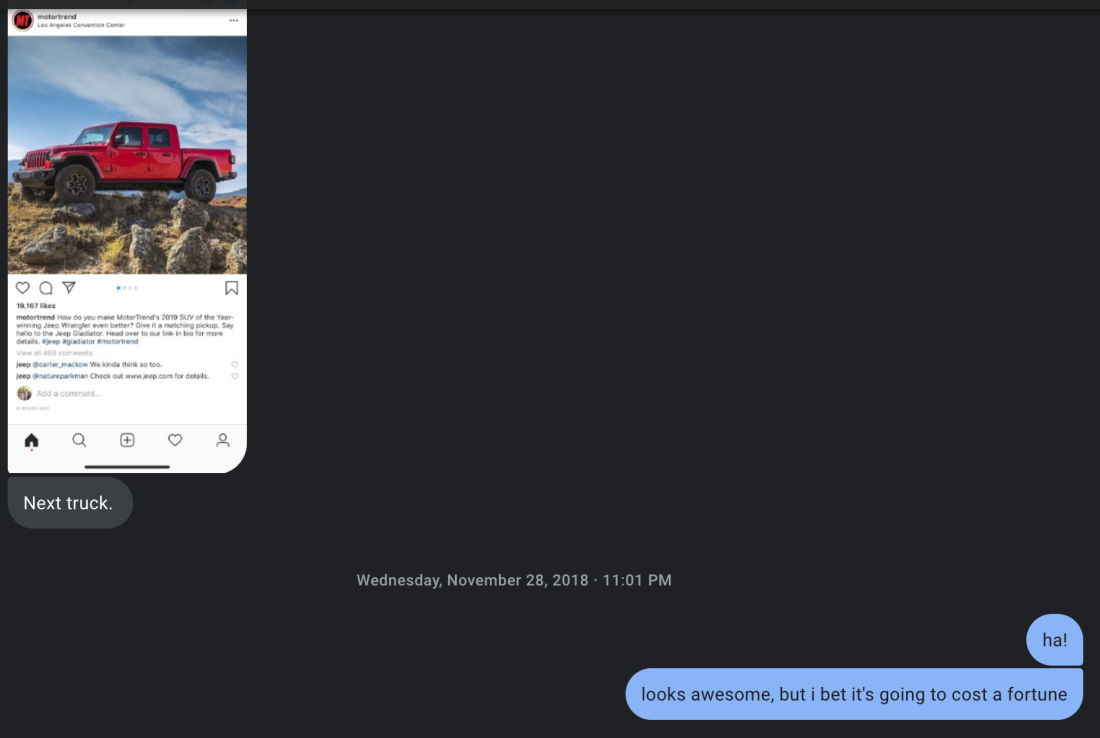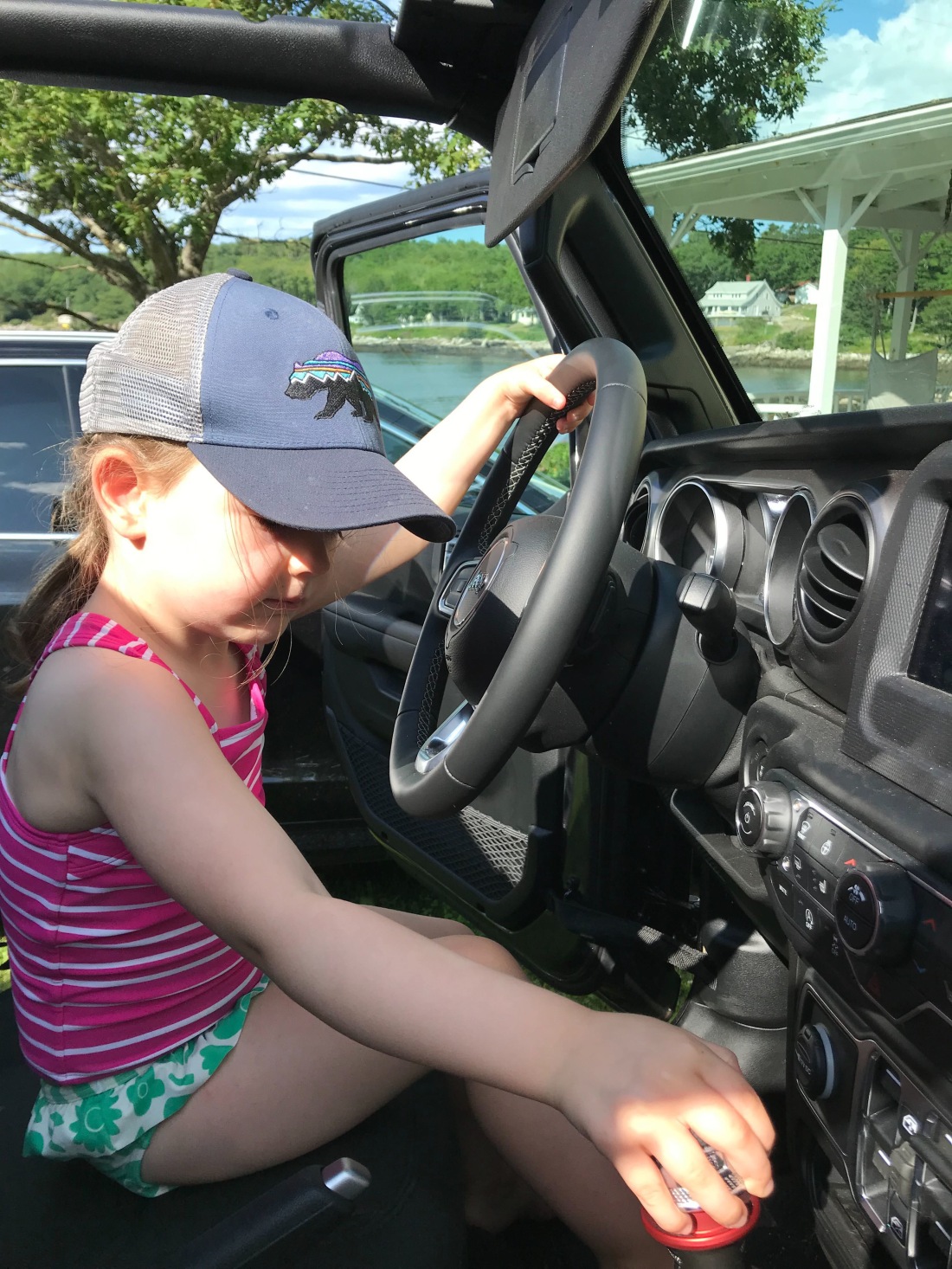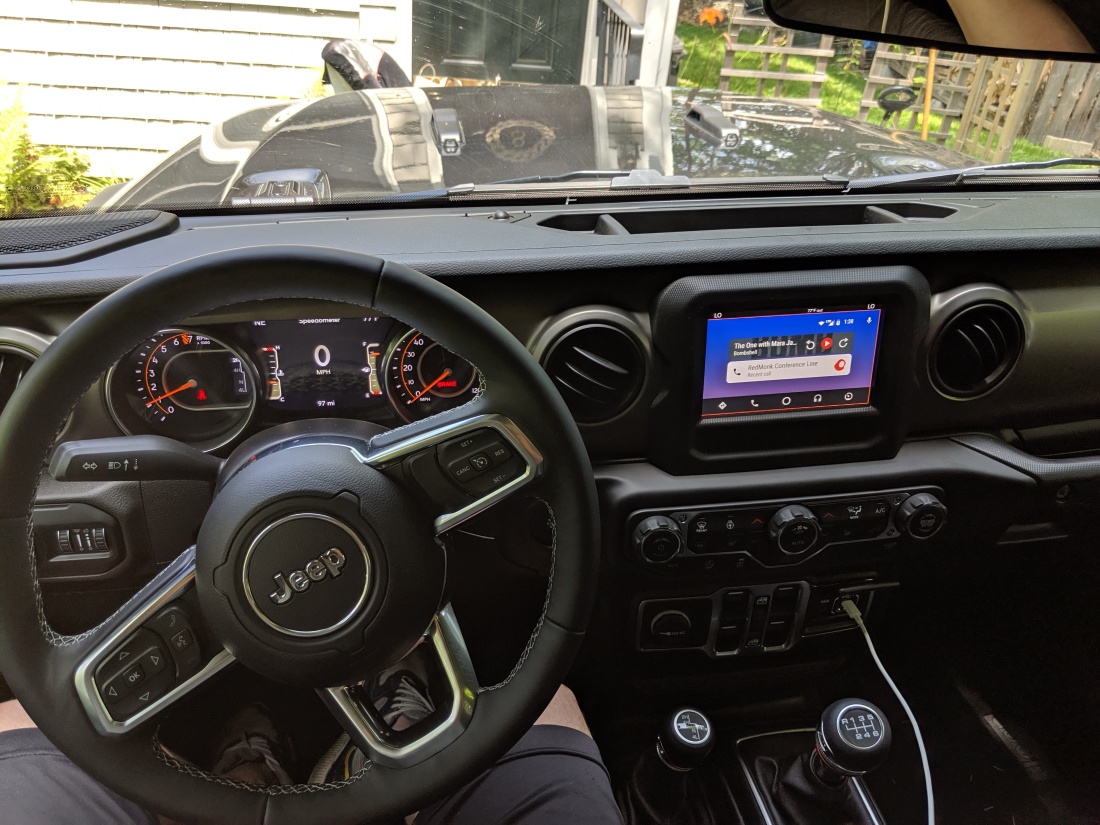A little over a month ago, I drove home from Westbrook in a brand new truck. It was not, as I would have assumed a year or two back, another Tacoma. It was instead the first generation of a brand new truck, a sort of franken-truck that was relatedly the first pickup Jeep has sold since the sixties. The truck I drove home was a Jeep Gladiator.
I got a lot of questions when I originally leased the Tacoma three years ago; I’ve gotten an order of magnitude more about the Gladiator. For those confused about why I picked one up, or even what it is, this is for you.
What Even is a Jeep Gladiator?
This is the first question that people ask. The day I picked one up, some rando in a parking lot literally asked “what in the hell is that?” Someone else walked by, did a double take, nodded once and just asked, “is it awesome?” – but we’ll come back to the reactions this thing provokes.
Anyway, while Jeep’s answer to the question of what a Gladiator is involves lengthy discussions of parts borrowed from other truck lines the parent company owns, the simplest and also correct answer is that the Gladiator is exactly what it looks like: a Jeep Wrangler with a pickup bed pasted onto the back of it.
That also, helpfully, explains why I bought one. But before we get there, why a pickup?
Why a Truck?
Much as it may seem otherwise if you’ve driven up here, you are not in fact legally required as a resident of the great state of Maine to drive a pickup. You can drive an SUV, a Subaru or anything else that has four wheel drive. Probably some other cars too. All of which implies that I am driving a pickup voluntarily, a fact that is likely to baffle the many sports car enthusiasts at a minimum.
Three years ago, I became convinced that – based on our lifestyle and more particularly the state of our house – a pickup was more need to have than nice to have. As someone who’d always driven sports cars or at least sportier sedans, however, I had less than no interest in driving one. So I set about convincing Kate that she should be the one to drive a pickup. That plan went about as far as you think it would, and she ended up driving a Volvo and I ended up with a Tacoma.
The good news was that the truck was every bit as useful as anticipated. The Tacoma conveyed plywood, sheetrock, 2×4’s and 2×6’s, 10 foot sections of walnut, 12 foot sections of hard rock maple and more. It picked up firewood (more than once). It picked up a tablesaw. It picked up a lawnmower. It emptied our house on trash day. It even got pressed into service for the Monktoberfest. And that’s just the special event stuff; the truck also did basic blocking and tackling like picking up mulch, mulch and more mulch in the spring or our weekly runs to the transfer station, recycling and bottle redemption places – it’s really nice to not care if your trash or bottles leak because you can just hose out the bed.
Point is, the truck got used as a truck all the time, and a truck had become indispensable. With Kate not having changed her mind about pickups, then, I was in the market for one.
Why a Gladiator?
This whole thing began with a single text from my brother – the car person in our family – from last November. It included a picture of the not-yet-on-sale Gladiator with the minimalist caption, “next truck.”

That kicked off a long, winding road leading here which careened between extremes like “they’re reportedly going to sell them for $10K over list so I’m out” to “wait, they’re leasing it for what?” In the end, the reality was closer to the latter, and I got the truck for below invoice and within a couple of grand of what the Tacoma had cost three years ago.
But that’s just the logistics that made it possible; it doesn’t get at the actual why.
Back in high school, when I was approaching the age I would be taking my driving test, I spent hours upon hours pouring over used car classifieds (for my younger readers, that’s like Craigslist printed on sheets of thin, black and white paper). I had two preferred options: a Wrangler or a sports car. The results were disheartening. Wranglers hold their resale value absurdly well, so they were a non-starter. Sports cars were similarly spendy, unless they had some near fatal flaw. The good news was that I ended up with a sports car, a ’73 Mustang bought off a coworker of my Mom’s that was, well, let’s just say not one of the classics aesthetically speaking. But it was my car and I loved it, and from that point forward I drove fast cars right until the time I ended up with the Tacoma.
When my brother sent me that text, however, I was faced with an interesting proposition. If I had to drive a truck rather than a sport car as circumstances seemed to dictate, what if that truck was a Wrangler at the same time? What if I could get a truck that was also a convertible? What if there was a truck whose doors and roof would come off in ten minutes?
The answer to these and other questions is sitting outside in our driveway as I write this.
Oh, and as an aside, if you own a Tacoma whose doors were not remotely designed to come off, I highly recommend not confessing to your significant other that you’ve been Googling about how to do that.
Why Did I Order One?
Once people get beyond the shock of the thing – it’s a Wrangler, but it’s a pickup? – one of the other questions people had is why did I order one? Most people, after all, buy off the lot because dealers are more incented to move those. I had certainly never ordered a car previously.
Part of it was the fact that I wanted a stick, and part of it was timing.

Since 2005, I’ve driven nothing but a manual transmission and had no intention of changing that. The good news was that the Gladiator’s default transmission was a standard. The bad news was that – default or no – virtually none of the early models that shipped out were manuals, and the few that were were far more richly optioned than my budget allowed for. Seriously, you wouldn’t believe what some people will pay for a pickup truck.
Under other circumstances, I’d simply bide my time and wait for manuals to start shipping. In my case, however, the Tacoma lease was up in June and even automatic-equipped Gladiators were few and far between at that point. I was able to extend my lease on a month to month basis, but the clock was ticking on the still expensive state registration. If I could get a new truck quickly, I’d be spared the hundreds of dollars necessary to register the old one that I’d be turning in anyway. If I waited for a suitable manual Gladiator to arrive on its own, meanwhile, I’d have to register the Tacoma for a full year, the majority of which I didn’t plan to own it – a waste of money.
Once I got one of the four Jeep dealers I was working with down to a workable number, then, I called it good.
What About the Environmental Impact?
Like every other reasonable, rational human being on the planet I’m desperately concerned about climate change, and its impact on the planet both near term but more for my daughter’s future. And while the Gladiator’s average mileage so far is a tick above what I was getting with the Tacoma and light years ahead of my old Mustang, there’s no way around this: the Gladiator is not in the least an environmentally friendly vehicle.
But for where we live and what we do, a pickup is a must have as discussed. Which is why part of the reason I leased the Tacoma was my hope that by the time that lease was up, hybrid or EV pickups would be available. The good news is that EV pickups exist now. The bad news is that they cost seventy grand, which is not only not in the ballpark of what I’m willing to spend, it’s not in the same league.
My hope with the Gladiator, therefore, is that three years from now, I’ll be able to get one that is an EV, or at worst a more efficient hybrid – something that looks increasingly plausible. Or failing that, that a Rivian, a Tesla or something similar has a pickup at a price point that is close enough to work (and has a dealership that is closer than several hundred miles away).
What About it Being a First Generation Vehicle?
A couple of people have asked whether I have any concerns about buying a first generation vehicle. The answer is an emphatic yes, and this is another reason I’m leasing. If Jeep’s first go round with the Gladiator turns out to be fatally flawed, I’m only on the hook for the early years and I can hand them the keys at the end of it and walk away.
How Does it Drive?
It drives like what it is, a truck. It’ll never be mistaken for my beloved old Volvo S40, let alone a true sports car, but it’s perfectly well mannered for a truck. One of the complaints about the Wranglers, from what I understand, is that because they’re short in wheelbase, they don’t track all that well, particularly on highways. The Gladiator, being a lot longer, has no such problem.
The manual transmission, for its part, is a lot closer to my Volvo than the Tacoma; the clutch is softer, and the throws are shorter and much more car-like. Once I got over the initial adjustment of not being able to feel the clutch engage because it wasn’t as hard as I was used to, it’s more pleasant to drive.
All in all, the driving experience is consistent with every other truck I’ve driven, and similar to at least the bigger SUVs.
How Big is the Bed?
It’s big enough for giant inflatable unicorns, at least.
More empirically, it’s slightly shallower, and thus easier to reach into, than my old Tacoma bed. Otherwise it’s a basically a standard midsize pickup bed.
The bed has one thoughtful little trick, though: you can suspend the tailgate halfway down to make it easy to carry full size sheets of plywood, sheetrock, etc.
What Don’t I like?
Let’s start with the bad stuff. The mileage is fairly standard for a midsize truck, but that’s another way of saying not good. While the Gladiator can tow an impressive amount of weight, the gear ratios are more oriented towards offroad usage than winding yourself up the gearbox. And even with the optional liners for the hard top, the road noise at highway speed is noticeable. A lot quieter than it would be with a soft top, but the truck is never going to be cathedral quiet.
The last thing to mention is not so much intrinsically bad as something that takes getting used to, and probably dependent on what you’re used to driving (and/or your personality). In my case, apart from my old Mustang which elicited comments – many of them not terribly complimentary – I’ve never driven a car or truck that was in the slightest way noticeable. They’ve all been fundamentally unremarkable, at least in terms of their outward appearance.
The Jeep, thus far, is the inverse of this. I have not driven anywhere without someone making some gesture or comment.
- “Is that the new Jeep truck? How is it?”
- “My husband really wants one, but I wanted to see one first.”
- “My husband and I had one like that in the sixties; we had a great time with it.”
- “I’m sorry, I just have to check it out.”
- “So do you call it a Juck or a Treep?”
Then there are experiences like the following.
I was in our local hardware store picking up some caulk to seal up a new front entry light when I noticed that one of the staff members appeared to be furtively stalking me. This isn’t totally unusual, because they tend to assume you don’t know how to find what you’re looking for. Anyway, he poked his head around a corner, looked back and forth almost as if afraid of getting caught at something, then walked over. While I got ready to tell him I was all set and had found the caulk, he stammered out a question like he had to work up his courage to ask: “I, uh, sir, I…is…is that your truck outside?” Allowing that it was, we chatted a bit about it and I answered a few questions.
Outside in the truck queuing up a podcast for the ride home, I happened to look up. The kid had pulled over two of the other kids working in there, and they were standing in the doorway gawking and pointing at the truck. They at least had the sense to be embarrassed when I caught them at it, however.
On the one hand, it’s nice that people are so enthusiastic about something you drive, but as someone who’s not generally in the habit of making random conversation with strangers, it’s also deeply weird. People really do seem infatuated with it, though.
What I Like?
Way more than I can list here, but as mentioned it drives well and predictably, the manual transmission is solid and the interior is both comfortable and can be hosed out and drained through plugs in the floor if necessary.

I’m really enjoying Android Auto, meanwhile. At the time I leased the Tacoma, Toyota was still trying and mostly failing to compete with both Apple and Google on user interfaces (they’ve since given that up). Android Auto isn’t perfect, and I’ve submitted a bunch of bugs ranging from trivial (the steering wheel track advance hardware buttons occasionally don’t work) to actively irritating (phone calls routed to the handset instead of the in-car audio mic/speakers), but overall it’s a lot more functional than Toyota’s old interface. From the Google Maps native integration to the mostly reliable voice operation of Google Play Music, Pocketcasts, and so on, Android Auto’s been an upgrade in my experience. It’s also a timely upgrade because as of Thursday Maine is going to begin ticketing drivers using their phones and I can now navigate the entire entertainment system with the Google Assistant’s voice interface.
The interior of the Jeep is also surprisingly roomy. The back seats fit adults capably and even our off-the-charts tall soon-to-be four year old has plenty of room. Kate’s primary complaint with the Tacoma was that she felt claustrophobic in it; no such complaints with the Gladiator, and that was with the roof on.
Speaking of Kate, for those trying to sell significant others on a Gladiator, the spousal approval factor in our house is far higher than I had anticipated. The no roof experience was such a hit, in fact, that she requested an extended evening drive out in the country the day I brought it home.
There are a hundred other things I could mention here, but honestly the thing I like best is the reason I bought it in the first place: the roof and doors come off. The first time you’re driving around on a hot day in the summer in the open air, well, if that doesn’t put a smile on your face I don’t know what could.
What’s it Like in the Winter?
I’m about to find out. Check back with me next spring, could be I’ll have a Jeep truck to sell you, cheap.
So, Is it Awesome?
‘Tis.
One thought on “What Even is a Jeep Gladiator?”